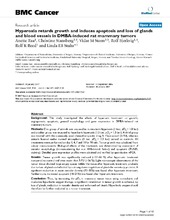Hyperoxia retards growth and induces apoptosis and loss of glands and blood vessels in DMBA-induced rat mammary tumors
Raa, Anette; Stansberg, Christine; Steen, Vidar Martin; Bjerkvig, Rolf; Reed, Rolf K.; Stuhr, Linda Elin Birkhaug
Journal article
Permanent lenke
http://hdl.handle.net/1956/2208Utgivelsesdato
2007-01-30Metadata
Vis full innførselSamlinger
- Department of Biomedicine [710]
- Department of Clinical Medicine [2065]
Originalversjon
https://doi.org/10.1186/1471-2407-7-23Sammendrag
This study investigated the effects of hyperoxic treatment on growth, angiogenesis, apoptosis, general morphology and gene expression in DMBA-induced rat mammary tumors. Methods: One group of animals was exposed to normobaric hyperoxia (1 bar, pO2 = 1.0 bar) and another group was exposed to hyperbaric hyperoxia (1.5 bar, pO2 = 1.5 bar). A third group was treated with the commonly used chemotherapeutic drug 5- Fluorouracil (5-FU), whereas animals housed under normal atmosphere (1 bar, pO2 = 0.2 bar) served as controls. All treatments were performed on day 1, 4, 7 and 10 for 90 min. Tumor growth was calculated from caliper measurements. Biological effects of the treatment, was determined by assessment of vascular morphology (immunostaining for von Willebrandt factor) and apoptosis (TUNEL staining). Detailed gene expression profiles were obtained and verified by quantitative rtPCR. Results: Tumor growth was significantly reduced (~57–66 %) after hyperoxic treatment compared to control and even more than 5-FU (~36 %). Light microscopic observations of the tumor tissue showed large empty spaces within the tissue after hyperoxic treatment, probably due to loss of glands as indicated by a strong down-regulation of glandular secretory proteins. A significant reduction in mean vascular density (30–50%) was found after hyperoxic treatment. Furthermore, increased apoptosis (18–21%) was found after hyperoxic treatment. Conclusion: Thus, by increasing the pO2 in mammary tumor tissue using normobaric and moderate hyperbaric oxygen therapy, a significant retardation in tumor growth is achieved, by loss of glands, reduction in vascular density and enhanced cell death. Hyperbaric oxygen should therefore be further evaluated as a tumor treatment.
